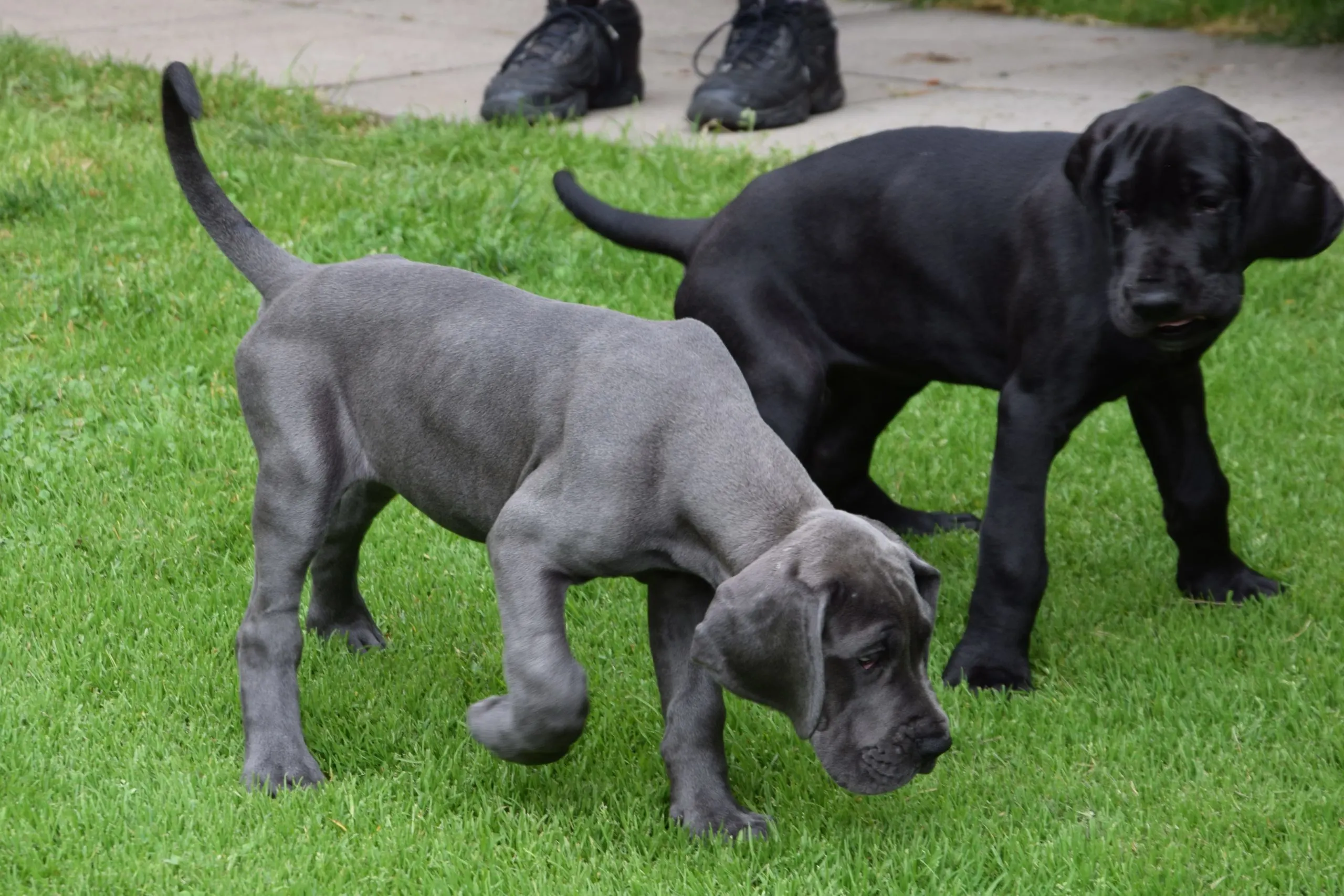We are huge fans of Great Dane dogs around here. And how couldn’t we be? These dogs are literal angels walking on Earth with us. They have the biggest hearts and gentle personalities, and even though they are giants, they still consider themselves lap dogs. While Scooby Doo made fawn Great Danes known worldwide, did you know that there are plenty of other coat colors to choose from? You really have a wide variety, and each of the colors is absolutely stunning in its own unique way. However, you might be wondering “What is the rarest Great Dane color?”.
In this article, we will go over all of the coat colors that these family pets can have. We will explain which of them are rare and if there are some important things that you should know before adopting one of these puppies. We will also explain if there are certain price differences. So let’s dive in and learn all about the colorful world of Great Danes.
What are the 7 official Great Dane colors?
There are two types of coat colors that your Great Dane could have: official and unofficial coat colors. But what does that actually mean? The official Great Dane colors are recognized by the American Kennel Club and Great Dane Club of America. They are part of the breed standard, and dogs with these coats usually can take part in different dog shows. For each official color, there is also a set of rules in terms of white markings, patches, black spots, patterns, and more.
But besides these standard Great Dane colors, there are also additional colors available that can’t be found in the breed’s standard description. These are the unofficial Great Dane colors, and we will talk more about them later in the article.
But back to the official colors of the Great Dane breed, there are actually seven available. These seven colors include black, fawn, merle, mantle, harlequin, blue, and brindle. All of these colors are absolutely stunning, however, some of them are rarer and harder to find than others. So let’s see what each of these colors has to offer.
Are blue Great Danes rare?
Contrary to popular belief, blue Great Danes are not extremely uncommon. Blue Merle and Blue Harlequin, on the other hand, are rare and less common tints. Having a steel-blue or dusty blue-grey coat, amber eyes, a blue nose, and blue paw pads distinguish a Great Dane as being blue.
The recessive blue gene is present in every Blue Great Dane puppy at birth. It changes the Great Dane’s black coat to one with a diluted blue hue. You might have a chance of getting a Blue Great Dane puppy with blue eyes that actually stay blue throughout his whole life.
The price range for blue Great Dane puppies is predicted to be $800–$2000 at most. However, the cost of a Blue Great Dane puppy may vary based on where you live and the breeder from where you are purchasing one. Reputable breeders who have a long line of healthy Dane puppies typically charge more.
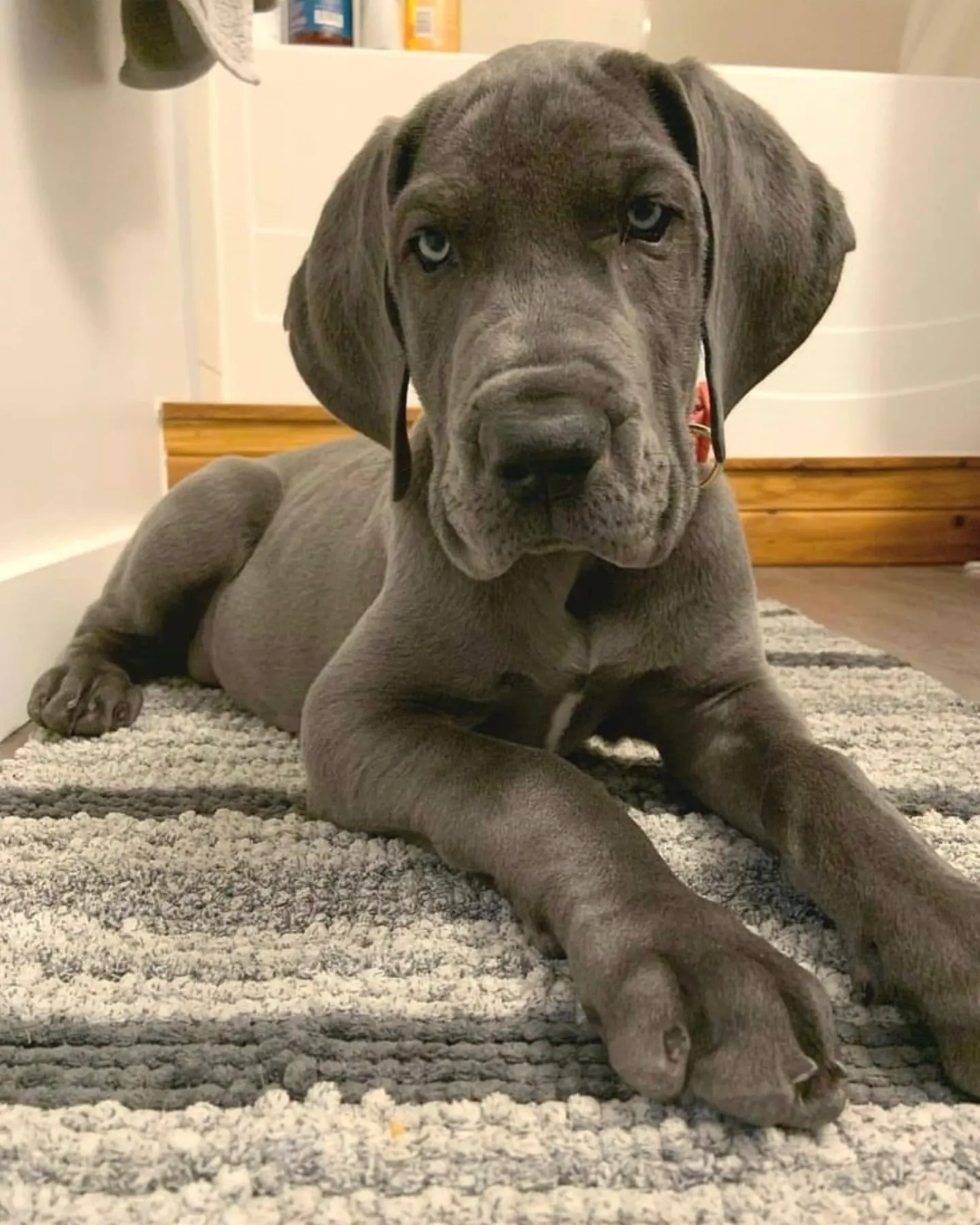
Source: Instagram (@greatdanesentuidis)
Is a fawn Great Dane rare?
Did you know that Scooby Doo was actually a fawn Great Dane? While there are colors that are more popular at the moment, fawn Great Danes are still very common, and we can’t consider them as being rare. A fawn coat describes a light brown coat color, most commonly with a black muzzle, and darker brown ears.
Because this is such a common color, it shouldn’t be too hard to get your hand on one of these puppies. And in addition to being completely adorable, these dogs may even make you feel a bit nostalgic. They are a real-life version of one of our favorite cartoon characters after all. Right?
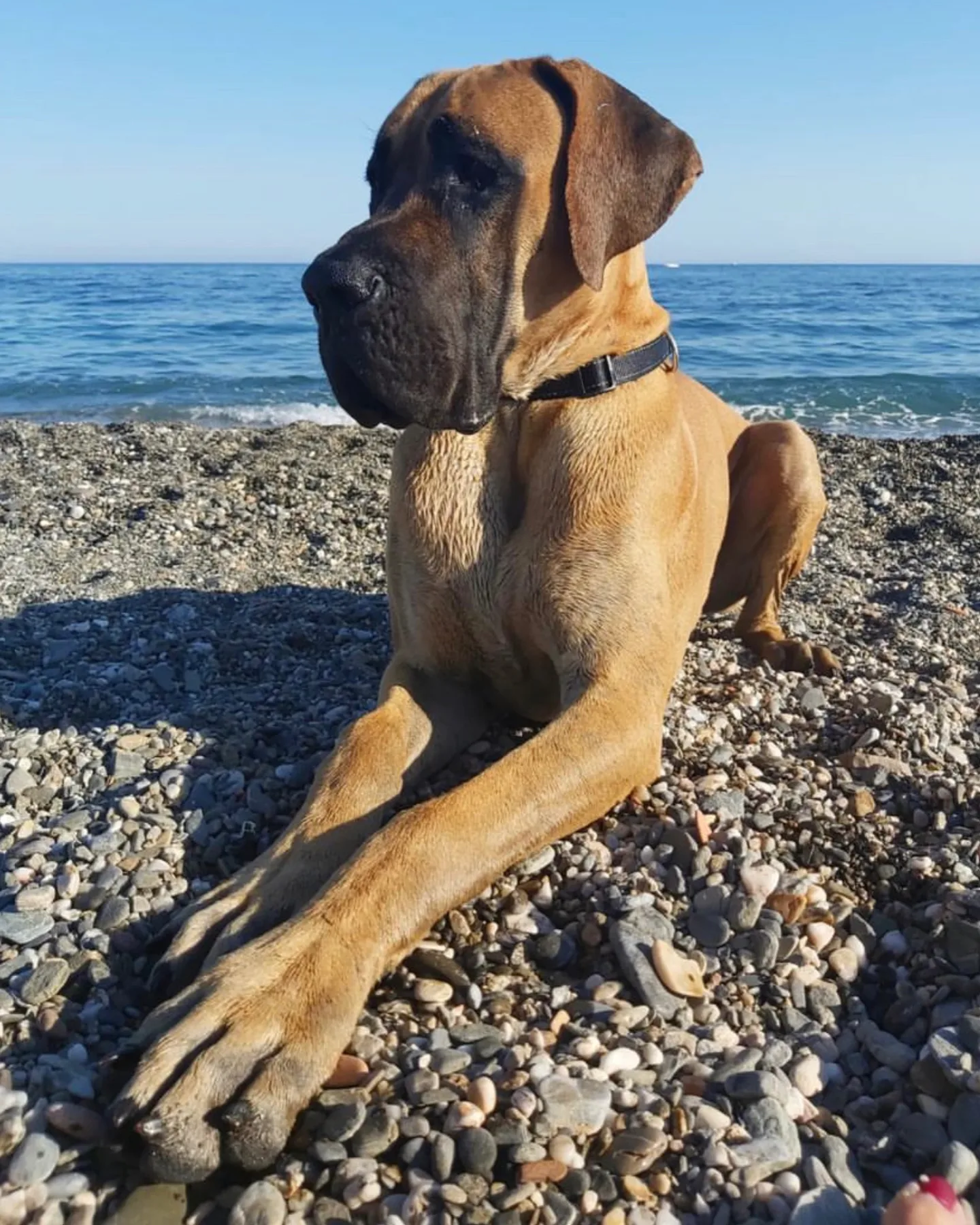
Source: Instagram (@kayo_the_great_dane)
What are brindle Great Danes?
The brindle Great Dane has a series of stripes or patterns in many color combinations, such as fawn and black, red and black, charcoal and gray, and many more. A well-bred brindle Great Dane, in addition to being a gigantic tall dog, is the most affectionate, pleasant, sweet, and lively companion who loves to hang out with kids and is extremely cautious around them.
Fawns and brindles belong to the same color family. All of the canines in this family are genetically stable and have undergone an autosomal dominant genetic alteration to give them brindles. One copy of the altered or changed gene (mutant gene) and one normal gene are present on each pair of chromosomes in the affected dog according to the autosomal dominant modification pattern of heredity.
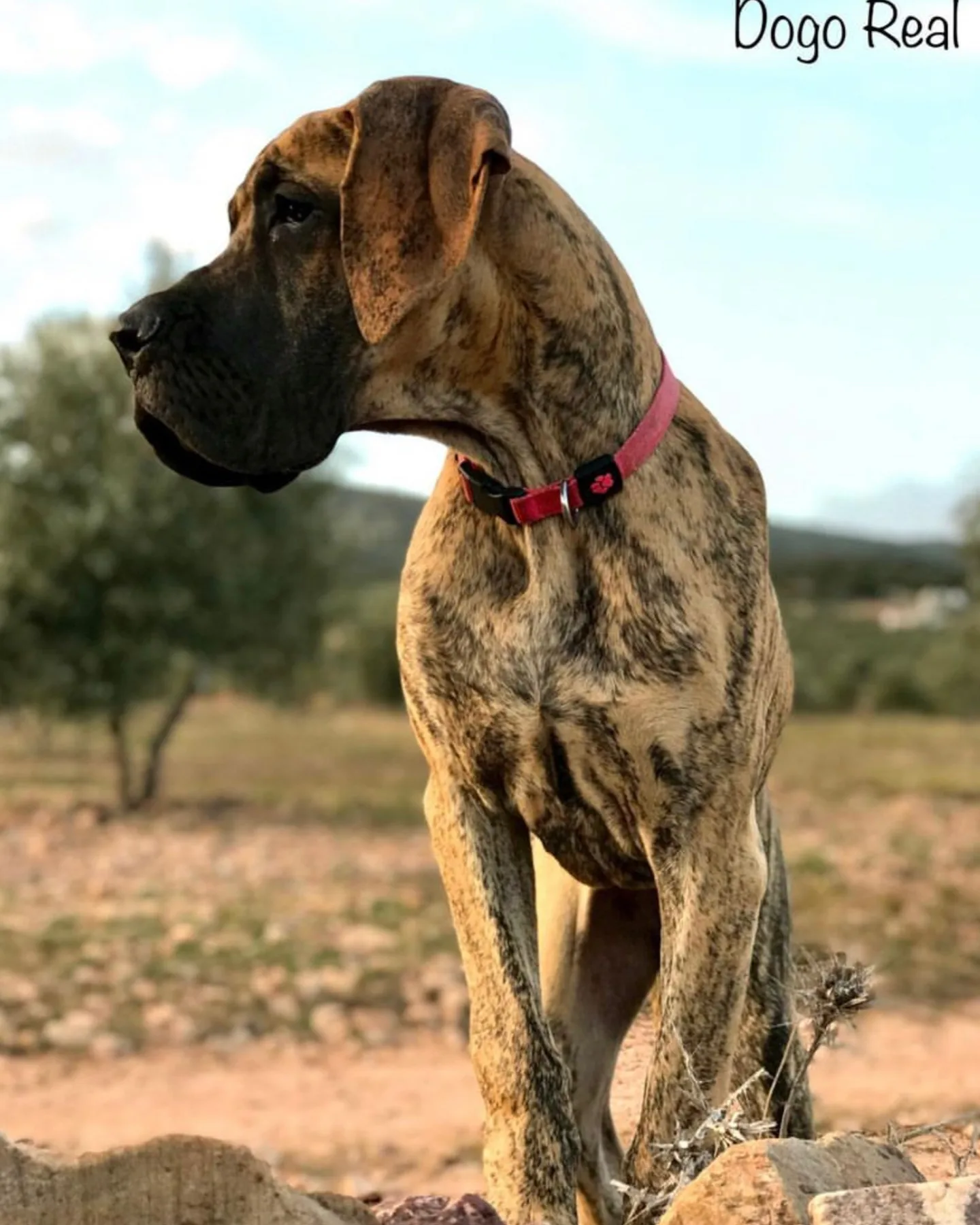
Source: Instagram (@dogoaleman_dogoreal)
Are all black Great Danes rare?
Solid black Great Danes are rare. However, black Danes with white markings on the chest are common to come across. A Black/Black mating results in pure-black Great Danes. If one or both parents have the “blue” gene, blue Great Danes may also be born.
The huge aura that a black Great Dane emits is a popular choice for dog shows. It’s difficult to describe how well the dog displays itself in words. The Black Great Dane canines exudes an incredible sense of nobility. It gleams and glistens in the sunlight with brilliance and radiance. We know that everything looks better in black, and the same rule applies to Great Danes.
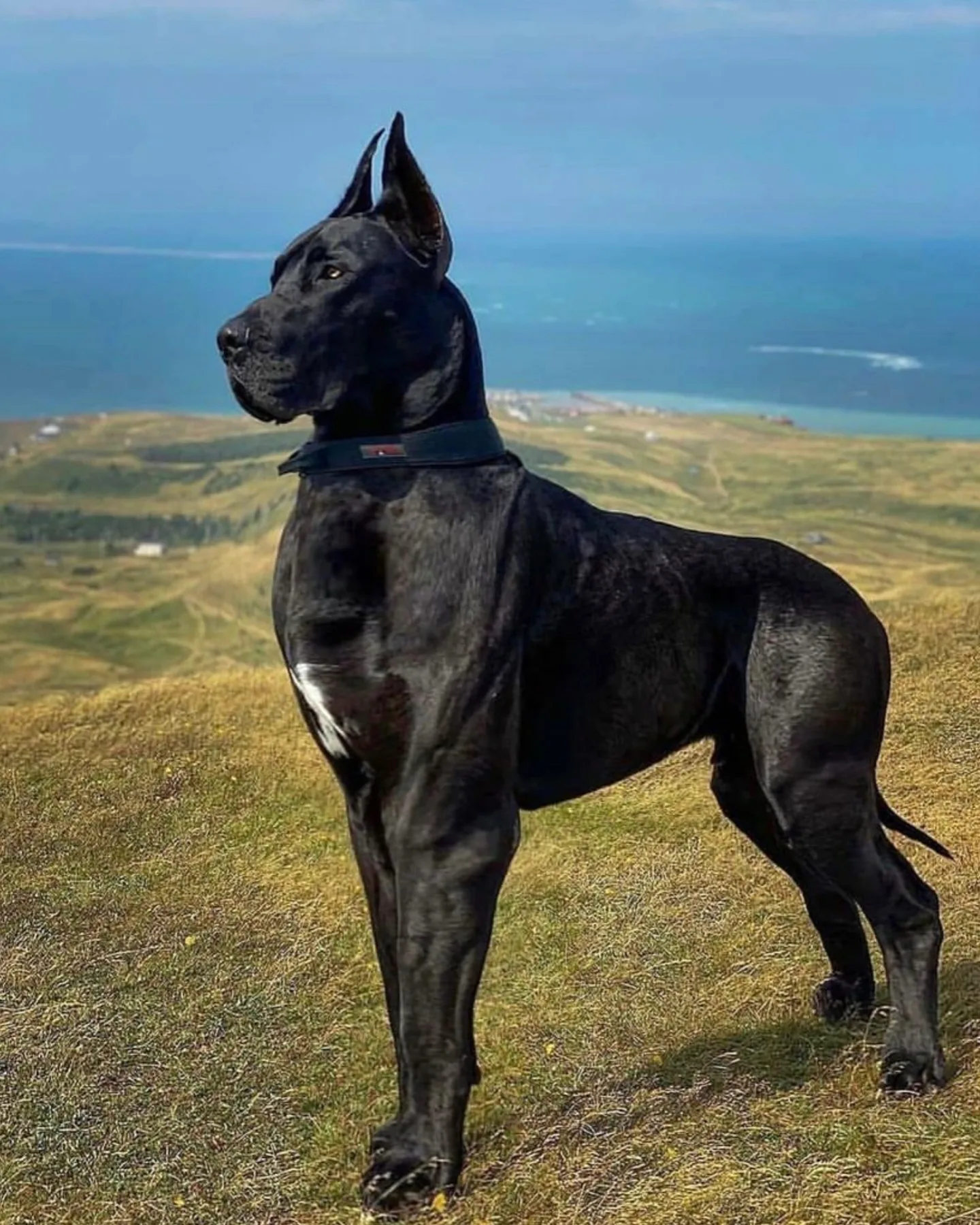
Source: Instagram (@greatdanesentuidis)
What is a Harlequin Great Dane?
A harlequin Great Dane has a white base color coat with irregularly shaped black patches uniformly scattered across the body. Due to the resemblance of their coats, Dalmatians and Great Danes can occasionally be confused. The fundamental distinction between a harlequin and a merle Great Dane is in their base coat color. Merle Great Danes have a base coat that ranges from light to dark merle, as opposed to harlequins, who have a white base coat.
According to the American Kennel Club’s breed standard, Harlequin Great Danes have a white coat with black spots or “patches,” a white neck, and black or spotted ears. The coat may also have various sizes and shapes of gray spots or patches. Any color variation that deviates from the American Kennel Club’s breed standard for show-quality Harlequin Great Danes can’t compete in dog shows.
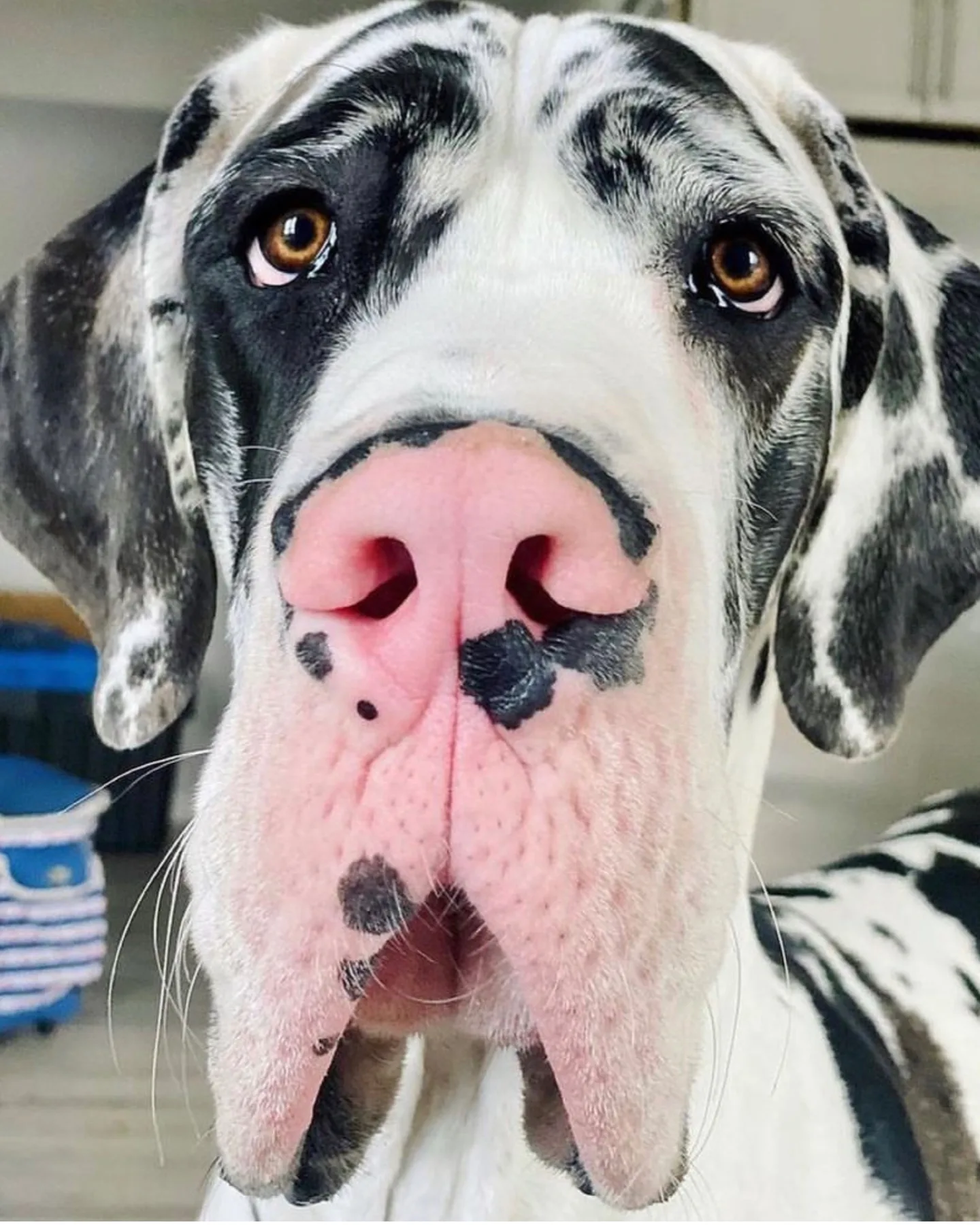
Source: Instagram (@greatdane_lovers)
Are merle Great Danes rare?
The merle Great Dane isn’t really considered to be rare. They are less common than fawn Danes, for example, however you still can’t tell that they are rare. In case you are confused about what merle means, a merle coat is a pale to medium grey base coat color, covered in black spots and splotches. They do look similar to harlequin Danes, however, their base color is grey instead of white.
These dogs can also have different white patches on their bodies, like on their chest or paws. Merle is a dominant gene, which is important to remember when breeding dogs. You should never breed two merle Great Danes because a double merle Dane most commonly turns out white. We will talk later about white Great Danes, but let’s just say that these puppies come with numerous health issues.
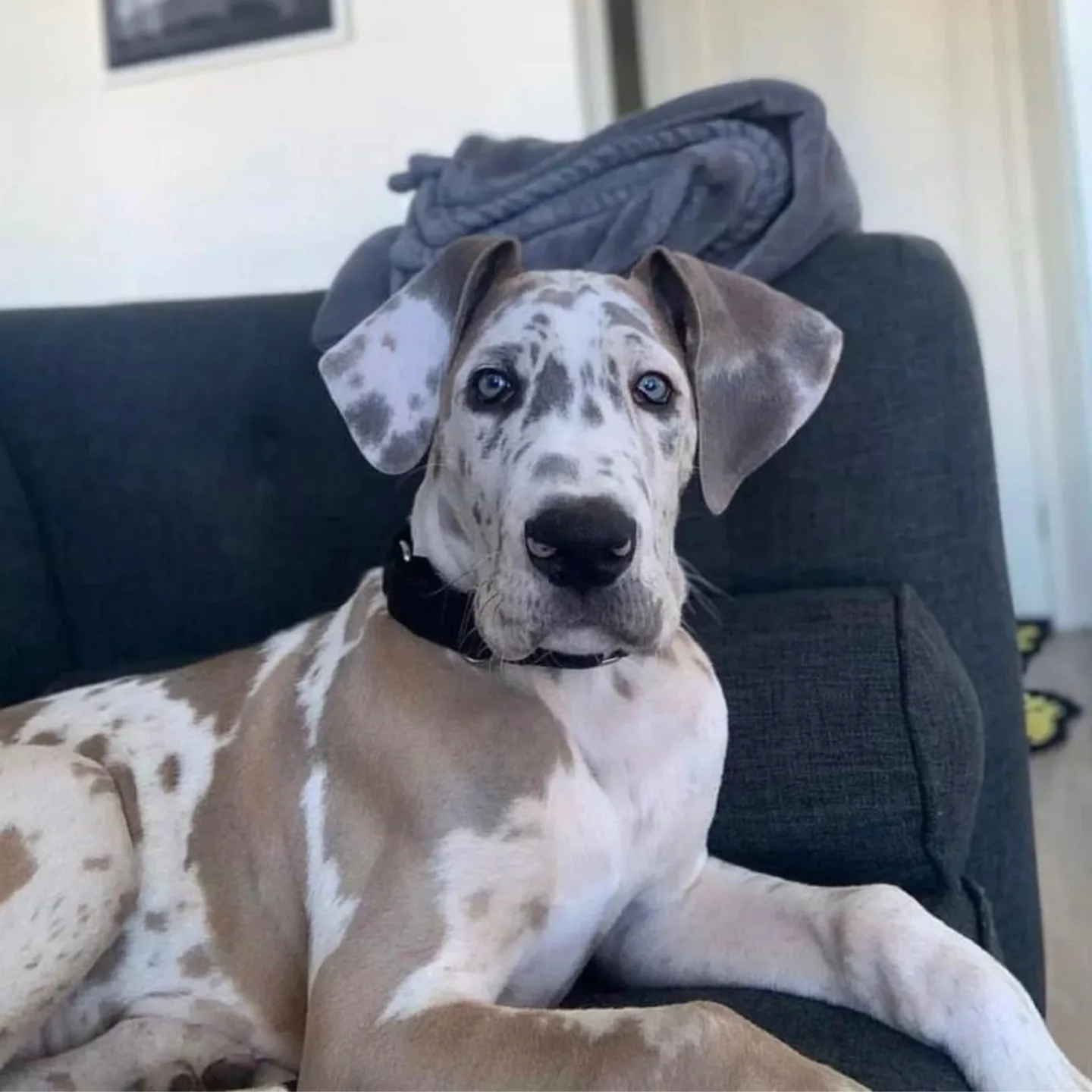
Source: Instagram (@greatdane_igtol)
What are mantle Great Danes?
A black-and-white variation of the Great Dane is known as a Mantle Great Dane. Their bodies are mostly covered in a black coat, with white markings around the neck and torso. They frequently have the appearance of being wrapped in a black blanket, and they have Boston Terrier-like markings.
Although the majority of Great Danes with mantles are black and white, there are different color combinations such as blue mantles and merle mantles. However, these do not fall under the AKC standard. The American Kennel Club defines the mantle, Great Dane, as being “black and white with a solid black blanket across the body.
A mantle Dane can be produced by breeding two mantles or a mantle with a harlequin. A harlequin is frequently mistaken for a dalmatian because of its uniformly black patches and the predominately white base color. As a common breed, the mantle Great Dane may cost the same as other Great Danes when they are easily accessible, while prices may rise if they are more difficult to find at that current time.
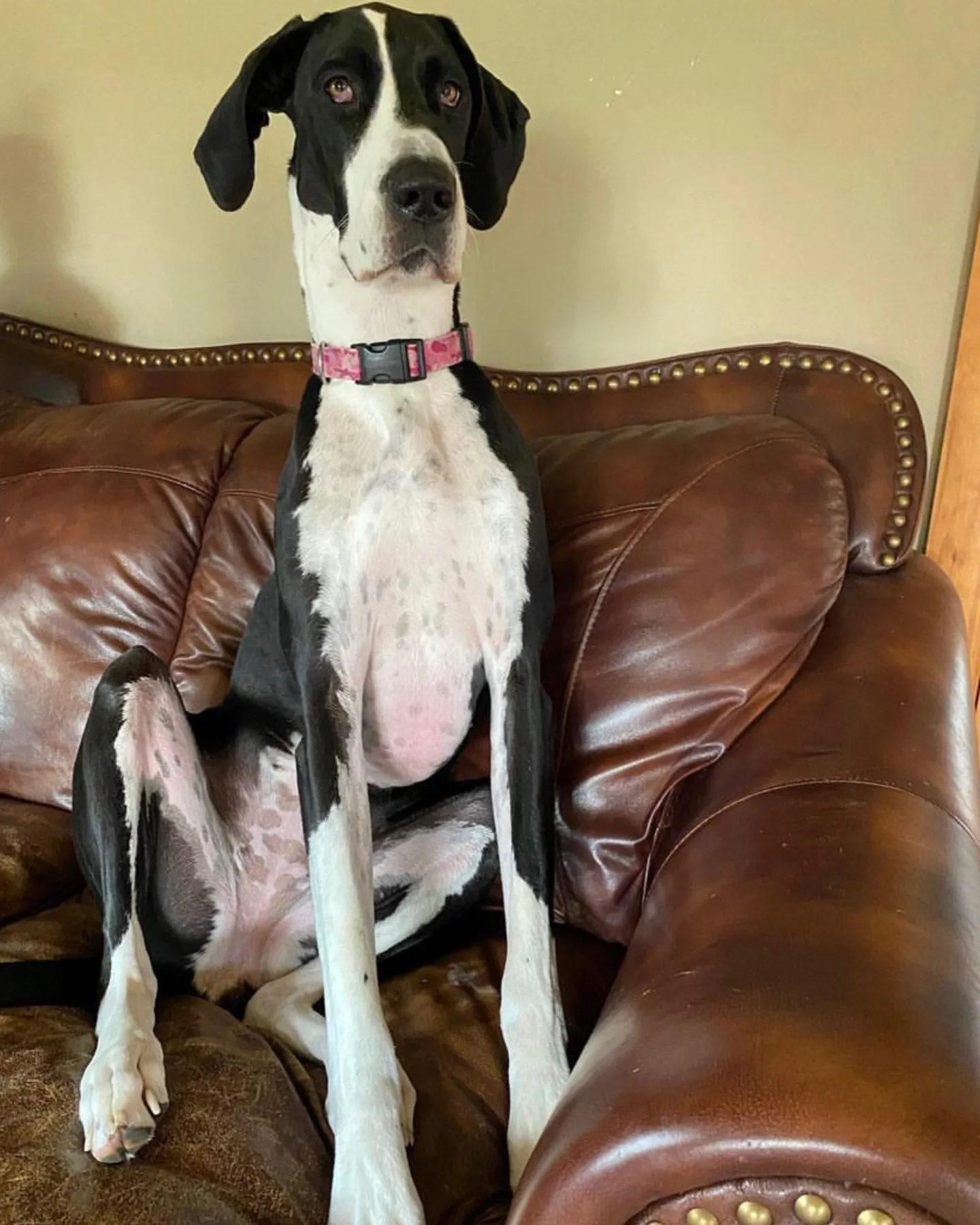
Source: Instagram (@normy_the_great)
What are the 5 unofficial colors of Great Danes?
Besides the seven official colors of the Great Danes, there are also five unofficial ones. These colors include white, black and white, piebald, grey (silver), and fawnequin. Unofficial means that these colors aren’t accepted by the Great Dane Club of America, and that you can’t register them with the American Kennel Club. Needless to say, Great Danes in one of these five colors, also can’t take part in dog shows. These colors are considered to be undesirable, and there is a reason for that. Some of these colors are achieved by different genetic mutations, which means that they can be linked to different health problems.
We won’t go over each of these colors separately, we will only focus on the arguably most problematic one – white. However, we want to briefly describe them so that you have the basic information. Silver Great Danes are a more diluted version of Blue Great Danes. The dilution gene is linked to different health issues like alopecia, which explains why it’s considered undesirable.
Fawnequin is similar to Harlequin, but their spots are fawn, and not black. Piebald Danes is mostly white, with some small patches of color. While this sounds similar to a Harlequin, they actually have much fewer patches of color. Sometimes as little as one to two on the head. The black and white may sound similar to the Mantle Dane, but these are black dogs with only a few white patches.
Are white Great Danes rare?
Yes, they are. In fact, white is sometimes considered the rarest Great Dane color. When two dogs with the Merle gene are bred together, a dog with two copies of the Merle gene, or a double Merle, is generated, giving rise to white Great Danes. But there are specific problems associated with this breed color.
In addition to a white coat, the double Merle gene causes loss of color in the inner ear and ocular structures. Blindness and/or deafness can develop as a result of damage to their ear and eye components. The risks of getting a sick dog are simply too high, which is why we would discourage anyone who is in the market for buying a white Great Dane. There are so many other color variations available to choose from.
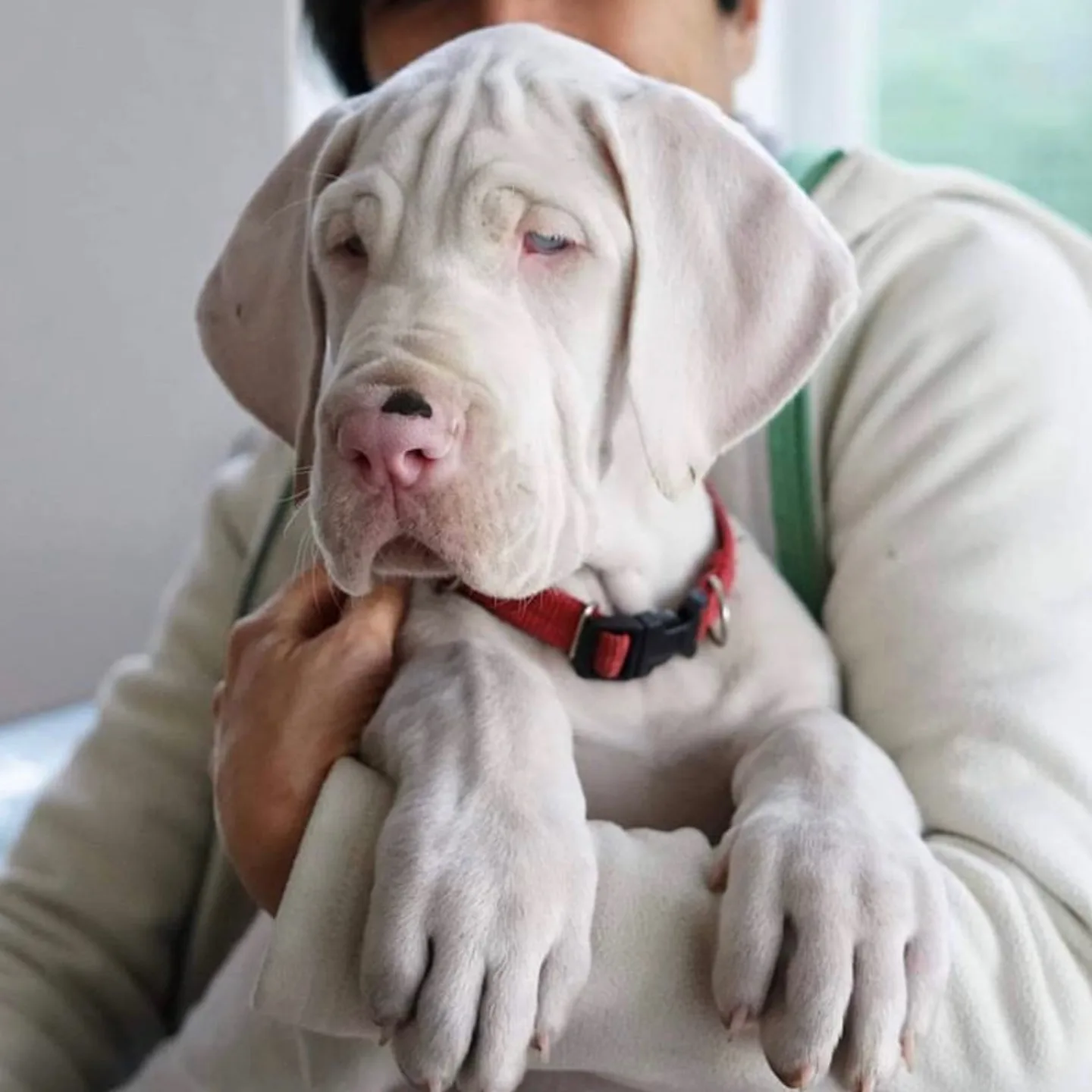
Source: Instagram (@irene_keraton)
What is the rarest Great Dane color?
There are different opinions on what the rarest color of Great Danes really is. When it comes to the official colors, some people claim it’s the Harlequin coat. However, other people say that the solid black version is the rarest color. While we can’t say with certainty which of these two is rarer, during our research on the web, it was much easier for us to find a Harlequin puppy, than a truly solid glossy black one. So take that information as you would like, but we would guess that a solid black one may be rarer.
When it comes to unofficial colors, there are also two schools of thought. Some claim that white is the rarest color, while others claim it’s silver. Personally, I would love to believe that white ones are harder to find because the breeding of these puppies is completely unethical. They are born with certain disabilities that make their lives so much harder than they have to be. However, there aren’t any official records that can tell us with certainty which of these two coat colors is harder to find.
What is the best Great Dane color?
We can’t decide for you what the best color for Great Danes is. The best color for you will be the one you like the most. There are so many great colors to choose from, however, we would suggest you to rather go for one of the official colors. That’s not because we believe that they are prettier than the unofficial colors, but instead, there is a breed standard that reputable breeders can follow. It’s just a bit safer for you as a buyer.
However, even if you don’t want to buy one of the standard colors, we would discourage you from buying a white Great Dane. As we have already explained, these dogs are often very sick. You could end up with a blind or deaf dog, or a dog with even more serious health conditions. Don’t support breeders who breed sick dogs on purpose because they are all interested in money. They don’t have the dog’s best interest at heart.
Bottom line
In conclusion, there are so many amazing Great Dane colors to choose from. The seven official colors come with many different markings, spots, or even patterns. You, as a potential Great Dane puppy buyer have so much variety. However, the coat color of your future dog shouldn’t be the most important thing when choosing a puppy. The color of their coat is really just that, it’s pretty superficial, and as for the seven official colors, their coat doesn’t have an impact on their personality and health.
When you are choosing a dog to adopt into your family, the most important thing should be his temperament and your compatibility. Great Danes are generally easy-going dogs, with good manners and sweet personalities. But, their personality still can vary from dog to dog. Pick a puppy that has the same pace in life as you do, and you are setting the two of you up to have a lifetime full of joy and love.
But if you have a strong preference when it comes to color, then pick the one you like the most. Maybe you want to own a real-life version of Scooby Doo. And hey, who could judge you for that? I know I couldn’t. However, you always have to see the full picture. This is why we would again discourage you from buying a puppy with genetic defects. While a white Great Dane is absolutely stunning, by buying one of these puppies you are supporting a breeder who is not in the job for the right reasons. So make sure you think twice before you do it.

